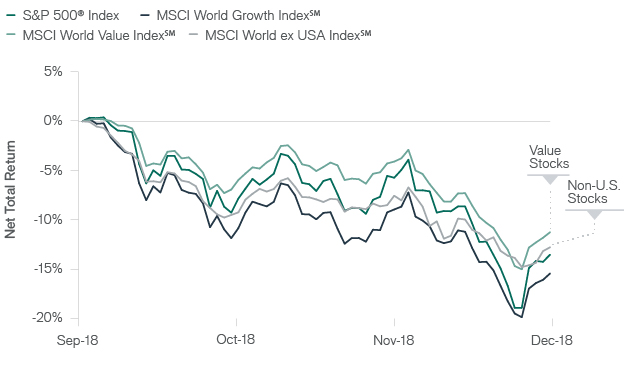Subscribe
Sign up for timely perspectives delivered to your inbox.
A good friend once gave me some very helpful dating advice: “Just go with the flow.” You’ve found someone special. Now relax, accept things as they are and see what the other person wants to do. While this notion will be obvious to many people – insert social skills joke here – it was perspective-changing for me. And happily so, as I am now more than 11 years into married life.
Going with the flow will not be found in finance textbooks, descriptive and popular though it may be as an approach to investing. Perhaps it doesn’t sound technical enough. Momentum is probably the closest factor proxy. For many investors, it simply means buying what has been working. For a long time now, that has meant aggressively buying stocks, preferring growth to value and favoring the U.S. over non-U.S. markets. Financial market results at the end of 2018 – as rudely noted in fourth-quarter brokerage statements – demonstrate the risk to this approach. As the smoothly rising equity market suddenly became a sharply falling one, stocks in general were very weak and both non-U.S. and value outperformed.
Markets can turn on a dime and are unforgiving. Going with the flow can leave you nursing losses and wondering what happened. It is challenging, particularly in the circumstance, to keep emotions in check and thoughts clear. Investors would do well to better ground their approach instead of merely floating along with the recent trend. In this context, legendary value investor Benjamin Graham wrote, “You are neither right nor wrong because the crowd disagrees with you. You are right because your data and reasoning are right.” We share his view, believing the market is there to serve not inform you.
Value and non-U.S. stocks outperform during the fourth quarter, 2018

Source: Bloomberg. Data are from 9/28/18 to 12/31/18
At Perkins, one of the ways in which we ground our investment approach is by considering the downside risk of an investment before the upside potential. How much money could we lose in a realistic negative scenario for the company? This approach can help during good times, such as September 2018, to identify and attempt to avoid the most sizeable drawdown risks. Stocks trading with high multiples on strong earnings usually have a lot going for them, but look out below should any unforeseen negatives begin to develop. Conversely, in more bleak environments, such as this past December, having a clear view of realistic downside scenarios can give our analysts and portfolio managers the confidence to buy when the market is overwhelmed with selling but the risk, in our analysis, is quite limited.
Cyclical stocks continue to be of interest. The global economy, including the U.S., appears to have downshifted recently. Growth in U.S. gross domestic product (GDP) peaked in the second quarter of 2018 at 4.2%, whereas the New York Fed Staff Nowcast (which incorporates current data releases into the Federal Reserve Bank of New York’s GDP forecast) stands at 2.6% for the fourth quarter and even lower for the beginning of 2019. Data from China and Europe also indicate a slowing in growth. More importantly, estimates of corporate profits have declined. In October, Bloomberg consensus estimates for 2019 earnings per share in the S&P 500 were $179; as of February 5, the figure was $168, a decline of 6%.
Pessimism has, to an extent, settled into the stock price of many cyclical companies. In many cases, valuations are quite low, at least as judged against current profits. However, those profits could be at peak-cycle levels, making valuations and leverage ratios less attractive on closer inspection. It is in this context – assessing downside profit levels for the cyclicals – that macro policy comes into play. As much as we prefer to be bottom-up in our analysis and hold no illusions as to our economic forecasting ability, we can’t help but notice the seemingly limited ability of central banks and governments to provide additional stimulus. We’re left wondering, should the economy in fact downshift all the way into a recession, what will trigger a bottoming and eventual recovery? The difficulty and complexity of the macro situation today is perhaps demonstrated by the recent and abrupt dovish turn of central bankers in the U.S., eurozone and Japan. Still, our team remains grounded in our investment process, and we’ve identified opportunities in hard-hit areas, including credit cards, banks and autos.
Recent market turbulence also highlights the importance of maintaining a balanced portfolio. We favor portfolios with many different drivers of cash flows, book values and valuation multiples that underlie the individual securities held. Particularly in December, it was unlikely a stock investor completely avoided price declines. This can be troubling if your portfolio is capturing 100% or more of the downside realized in the broad market. However, sustaining some losses is much more manageable in the context of a well-diversified portfolio where not all stocks are losing badly and, perhaps, (ideally) some are even gaining. We believe select pharmaceuticals, consumer staples and utilities can play a balancing role in portfolios today by offering resilience in the face of economic weakness.
What works in one sphere of life may not in another, and so it is with going with the flow. In investing, stick with Mr. Graham and maintain a viewpoint that is independent from the market.
Thank you for your co-investment with Perkins Investment Management.
Gregory Kolb
Chief Investment Officer,
Portfolio Manager
MSCI World ex USA IndexSM reflects the equity market performance of global developed markets, excluding the U.S.
MSCI World Growth IndexSM reflects the performance of growth stocks from global developed markets.
MSCI World Value IndexSM reflects the performance of value stocks from global developed markets.
S&P 500® Index reflects U.S. large-cap equity performance and represents broad U.S. equity market performance.